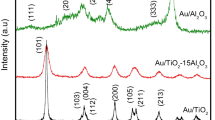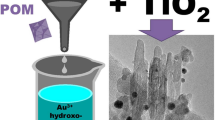Abstract
Iron doped TiO2 materials were prepared by the sol–gel method and used as supports of gold nanoparticles synthesized by the deposition–precipitation technique. The gold–iron–titania catalysts were characterized by X-ray diffraction, Raman spectroscopy, N2 physisorption, UV–Vis spectroscopy as a function of temperature, H2-temperature programmed reduction, transmission electronic microscopy and X-ray photoelectron spectroscopy. The gold–iron catalysts were catalytically active during the CO oxidation reaction at low temperatures, reaching CO conversion percentages of almost 80% at room temperature. The Au/TiO2–Fe catalyst surface was characterized through infrared spectroscopy (DRIFTS) during the CO oxidation reaction to elucidate the active sites and the real carbon monoxide interaction during the reaction. A 24-h deactivation test corroborated a final deactivation of the catalysts of only 25% for both Au/TiO2–Fe 1 and the bare Au/TiO2. The results here obtained corroborate that the activity of the iron-doped TiO2 catalyst was higher than that of the bare TiO2 due to the iron incorporation into the TiO2 lattice, which allows the formation of surface oxygen vacancies and new adsorption sites which favor the CO adsorption and its oxidation to CO2.
Graphical Abstract










Similar content being viewed by others
References
Haruta M, Kobayashi T, Sano H, Yamada N (1987) Novel gold catalysts for the oxidation of carbon monoxide at a temperature far below 0 °C. Chem Lett 16:405–408
Haruta M (2003) When gold is not noble: catalysis by nanoparticles. Chem Rec 3:75–87
Parida KM, Mohapatra P, Moma J, Jordaan WA, Scurrell MS (2008) Effect of preparation methods on gold/titania catalysts for CO oxidation. J Mol Catal A 288:125–130
Yu S, Yu HJ, Lee DM, Yi J (2012) Preparation and characterization of Fe-doped TiO2 nanoparticles as a support for a high performance CO oxidation catalyst. J Mater Chem 22:12629–12635
Delannoy L, Weiher N, Tsapatsaris N, Beesley AM, Nchari L, Schroeder SLM, Louis C (2007) Reducibility of supported gold (III) precursors: influence of the metal oxide support and consequences for CO oxidation activity. Top Catal 44:263–273
Andreeva D (2002) Low temperature water gas shift over gold catalysts. Gold Bull 35:82–88
Macwan DP, Dave PN (2011) A review on nano-TiO2 sol-gel type syntheses and its applications. J Mater Sci 46:3669–3686
Carretin S, Hao Y, Aguilar-Guerrero V, Gates BC, Trasobares S, Calvino JJ, Corma A (2007) Increasing the number of oxygen vacancies on TiO2 by doping with iron increases the activity of supported gold for CO oxidation. Chem Eur J 13:7771–7779
Parida KM, Sahu N, Mohapatra P, Scurrell MS (2010) Low temperature CO oxidation over gold supported mesoporous Fe–TiO2. J Mol Catal A 319:92–97
Mohapatra P, Moma J, Parida KM, Jordaan WA, Scurrell MS (2007) Dramatic promotion of gold/titania for CO oxidation by sulphate ions. Chem Commun. https://doi.org/10.1039/B614267B
Parida KM, Sahu N, Tripathi AK, Kamble VS (2010) Gold promoted S,N-doped TiO2: an efficient catalyst for CO adsorption and oxidation. Environ Sci Technol 44:4155–4160
Sahu N, Parida KM, Tripathi AK, Kamble VS (2011) Low temperature CO adsorption and oxidation over Au/rare earth-TiO2 nanocatalysts. Appl Catal A 399:110–116
Tang X, Zhang B, Li Y, Xu Y, Xin Q, Shen W (2005) CuO/CeO2 catalysts: redox features and catalytic behaviors. Appl Catal A 288:116–125
Moreau F, Bond GC (2006) CO oxidation activity of gold catalysts supported on various oxides and their improvement by inclusion of an iron component. Catal Today 114:362–368
Rodríguez-González V, Zanella R, Calzada LA, Gómez R (2009) Low-temperature CO oxidation and long-term stability of Au/In2O3–TiO2 catalysts. J Phys Chem C 113:8911–8917
Zanella R, Rodríguez-González V, Arzola Y, Moreno-Rodríguez A (2012) Au/Y-TiO2 catalyst: high activity and log-term stability in CO oxidation. ACS Catal 2:1–11
Hinojosa-Reyes M, Zanella R, Maturano-Rojas V, Rodríguez-González V (2016) Gold–TiO2–Nickel catalysts for low temperature-driven CO oxidation reaction. Appl Surf Sci 368:224–232
Hinojosa-Reyes M, Rodríguez-González V, Arriaga S (2012) Enhancing ethylbenzene vapor degradation in a hybrid system based on photocatalytic oxidation UV/TiO2-In and a biofiltration process. J Hazard Mater 209–210:365–371
Zanella R, Giorgio S, Henry CR, Louis C (2002) Alternative methods for the preparation of gold nanoparticles supported on TiO2. J Phys Chem B 106:7634–7642
Zanella R, Louis C (2005) Influence of the conditions of thermal treatments and of storage on the size of the gold particles in Au/TiO2 samples. Catal Today 107–108:768–777
Gennari FC, Pasquevich DM (1998) Kinetics of the anatase-rutile transformation in TiO2 in the presence of Fe2O3. J Mater Sci 33:1571–1578
Wang JA, Limas-Ballesteros R, López T, Moreno A, Gómez R, Novaro O, Bokhimi X (2001) Quantitative determination of titanium lattice defects and solid-state reaction mechanism in iron-doped TiO2 photocatalysts. J Phys Chem B 105:9692–9698
Devi LG, Kumar SG, Murthy BN, Kottam N (2009) Influence of Mn2+ and Mo6+ dopants on the phase transformations of TiO2 lattice and its photo catalytic activity under solar illumination. Catal Commun 10:794–798
Khan H, Swati IK (2016) Fe3+-doped anatase TiO2 with d–d transition, oxygen vacancies and Ti3+ centers: synthesis, characterization, UV–vis photocatalytic and mechanistic studies. Ind Eng Chem Res 55:6619–6633
McCusker LB, Liebau F, Engelhardt G (2001) Nomenclature of structural and compositional characteristics of ordered microporous and mesoporous materials with inorganic hosts (IUPAC recommendations 2001). Pure Appl Chem 73:381–394
Tompsett GA, Bowmaker GA, Cooney RP, Metson JB, Rodgers KA, Seakins JM (1995) The Raman spectrum of brookite, TiO2 (Pbc, Z = 8). J Raman Spectrosc 26:57–62
Narayanan PS (1950) Raman spectrum of rutile (TiO2). Proc Indian Acad Sci 32:279–283
Xin B, Ren Z, Wang P, Liu J, Jing L, Fu H (2007) Study on the mechanisms of photoinduced carriers separation and recombination for Fe3+–TiO2 photocatalysts. Appl Surf Sci 253:4390–4395
Singh A, Kumari S, Shrivastav R, Dass S, Satsangi V (2008) Iron doped nanostructured TiO2 for photoelectrochemical generation of hydrogen. Int J Hydrog Energy 33:5363–5368
Sandoval A, Aguilar A, Louis C, Traverse A, Zanella R (2011) Bimetallic Au–Ag/TiO2 catalyst prepared by deposition-precipitation: high activity and stability in CO oxidation. J Catal 281:40–49
Wang C, Liu C, Zheng X, Chen J, Shen T (1998) The surface chemistry of hybrid nanometer-sized particles I. Photochemical deposition of gold on ultrafine TiO2 particles. Colloids Surf A 131:271–280
Yu J, Xiang Q, Zhou M (2009) Preparation, characterization and visible-light driven photocatalytic activity of Fe-doped titania nanorods and first-principles study for electronic structures. Appl Catal B 90(3–4):595–602
Kruse N, Chenakin S (2011) XPS characterization of Au/TiO2 catalysts: binding energy assessment and irradiation effects. Appl Catal A 391:367–376
McCafferty E, Wightman JP (1998) Determination of the concentration of surface hydroxyl groups on metal oxide films by a quantitative XPS method. Surf Interface Anal 26:549–564
Santara B, Giri PK, Imakita K, Fujii M (2013) Evidence of oxygen vacancy induced room temperature ferromagnetism in solvothermally synthesized undoped TiO2 nanoribbons. Nanoscale 5:5476–5488
Su YS, Lee MY, Lin SD (1999) XPS and DRS of Au/TiO2 catalysts: effect of pretreatment. Catal Lett 57:49–53
Hakkinen H, Abbet S, Sánchez A, Heiz U, Landman U (2003) Structural, electronic, and impurity-doping effects in nanoscale chemistry: supported gold nanoclusters. Angew Chem Int Ed 42(11):1297–1300
Bokhimi X, Zanella R, Morales A, Maturano V, Angeles-Chávez C (2011) Au/Rutile catalysts: effects of the activation atmosphere on the gold-support interaction. J Phys Chem C 115:5856–5862
Bokhimi X, Zanella R, Angeles-Chávez C (2010) Rutile-supported Ir, Au, and Ir–Au catalysts for CO oxidation. J Phys Chem C 114:14101–14109
Haruta M (2004) Gold as a novel catalyst in the 21 st century: preparation, working mechanism and applications. Gold Bull 37:27–36
Hinojosa-Reyes M, Rodríguez-González V, Zanella R (2014) Gold nanoparticles supported on TiO2-Ni as catalysts for hydrogen purification via water–gas shift reaction. RSC Adv 4:4308–4316
Boccuzzi F, Chiorino A, Manoli M, Andreeva D, Tabakova T (1999) FTIR study of the low-temperature water-gas shift reaction of Au/Fe2O3 and Au/TiO2 catalysts. J Catal 188:176–185
Smith ML, Kumar N, Spivey JJ (2012) CO Adsorption behavior of Cu/SiO2, Co/SiO2, and CuCo/SiO2 catalysts studied by in situ DRIFTS. J Phys Chem C 116:7931–7939
Roze E, Gravejat P, Quinet E, Rousset JL, Bianchi D (2009) Impact of the reconstruction of gold particles on the heats of adsorbed on the Au sites of a 1% Au/Al2O3 catalyst. J Phys Chem C 113:1037–1045
Acknowledgements
The authors thank DGAPA UNAM and CONACYT for funding this work within the framework of projects IN105416 and 1216, respectively. This work is also supported by the CB-2011/169597 and CONACYT-2014 Infrastructure S-2780 projects. We wish to thank V. Maturano Rojas, B. Rivera Escoto, A. Herrera Gómez and H. G. Silva Pereyra for their valuable technical support.
Author information
Authors and Affiliations
Corresponding author
Rights and permissions
About this article
Cite this article
Hinojosa-Reyes, M., Camposeco-Solis, R., Zanella, R. et al. Gold Nanoparticle: Enhanced CO Oxidation at Low Temperatures by Using Fe-Doped TiO2 as Support. Catal Lett 148, 383–396 (2018). https://doi.org/10.1007/s10562-017-2260-9
Received:
Accepted:
Published:
Issue Date:
DOI: https://doi.org/10.1007/s10562-017-2260-9




